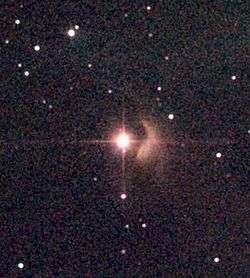T Tauri
 The star T Tauri with NGC 1555 cloud nearby. | |
| Observation data Epoch J2000 Equinox J2000 | |
|---|---|
| Constellation | Taurus |
| Right ascension | 04h 21m 59.43445s[1] |
| Declination | +19° 32′ 06.4182″[1] |
| Apparent magnitude (V) | 10.27[2] |
| Characteristics | |
| Spectral type | G5V:e |
| U−B color index | +0.80[2] |
| B−V color index | +1.22[2] |
| Variable type | T Tauri |
| Astrometry | |
| Radial velocity (Rv) | +24.6[3] km/s |
| Proper motion (μ) | RA: +15.51[1] mas/yr Dec.: -13.67[1] mas/yr |
| Parallax (π) | 5.48 ± 1.58[1] mas |
| Distance | approx. 600 ly (approx. 180 pc) |
| Details | |
| T Tau Sa | |
| Mass | 2.1 ± 0.2[4] M☉ |
| Age | 0.4[5] Myr |
| T Tau Sb | |
| Mass | 0.8 ± 0.1[4] M☉ |
| Other designations | |
T Tauri is a variable star in the constellation Taurus, the prototype of the T Tauri stars. It was discovered in October 1852 by John Russell Hind. T Tauri appears from Earth amongst the Hyades cluster, not far from ε Tauri; but it is actually 420 light years behind it and was not formed with the rest of them.
Like all T Tauri stars, it is very young, being only a million years old. Its distance from Earth is about 460 light years, and its apparent magnitude varies unpredictably from about 9.3 to 14.[6]
The T Tauri system consists of at least three stars, only one of which is visible at optical wavelengths; the other two shine in the infrared and one of them also emits radio waves. Through VLA radio observations, it was found that the young star (the "T Tauri star" itself) dramatically changed its orbit after a close encounter with one of its companions and may have been ejected from the system.

Physically nearby is NGC 1555, a reflection nebula known as Hind's Nebula or Hind's Variable Nebula. It is illuminated by T Tauri, and thus also varies in brightness. The nebula NGC 1554 was likewise associated with T Tauri and was observed in 1868 by Otto Wilhelm von Struve,[7] but soon disappeared or perhaps never existed, and is known as "Struve's Lost Nebula".
A Herbig–Haro object also appears to be associated with Hind's nebula, or perhaps with the T Tauri system itself.
The T Tauri wind, so named because this young star is currently in this stage, is a phase of stellar development between the accretion of material from the slowing rotating material of a solar nebula and the ignition of the hydrogen that has agglomerated into the protostar. A protostar is the denser parts of a cloud core, typically with a mass around 104 solar masses in the form of gas and dust, that collapses under its own weight/gravity, and continues to attract matter.
The protostar, at first, only has about 1% of its final mass. But the envelope of the star continues to grow as infalling material is accreted. After a few million years, thermonuclear fusion begins in its core, then a strong stellar wind is produced which stops the infall of new mass. The protostar is now considered a young star since its mass is fixed, and its future evolution is now set.
See also
References
- 1 2 3 4 5 van Leeuwen, F. (November 2007), "Validation of the new Hipparcos reduction", Astronomy and Astrophysics, 474 (2): 653–664, arXiv:0708.1752
 , Bibcode:2007A&A...474..653V, doi:10.1051/0004-6361:20078357.
, Bibcode:2007A&A...474..653V, doi:10.1051/0004-6361:20078357. - 1 2 3 Nicolet, B. (1978), "Photoelectric photometric Catalogue of homogeneous measurements in the UBV System", Astronomy and Astrophysics Supplement Series, 34: 1–49, Bibcode:1978A&AS...34....1N.
- ↑ Wilson, R. E. (1953), General Catalogue of Stellar Radial Velocities, Carnegie Institute of Washington, D.C., Bibcode:1953GCRV..C......0W.
- 1 2 Köhler, R.; et al. (May 2008), "Orbits and masses in the T Tauri system", Astronomy and Astrophysics, 482 (3): 929–938, arXiv:0802.3178
 , Bibcode:2008A&A...482..929K, doi:10.1051/0004-6361:20079269.
, Bibcode:2008A&A...482..929K, doi:10.1051/0004-6361:20079269. - ↑ Tetzlaff, N.; Neuhäuser, R.; Hohle, M. M. (January 2011), "A catalogue of young runaway Hipparcos stars within 3 kpc from the Sun", Monthly Notices of the Royal Astronomical Society, 410 (1): 190–200, arXiv:1007.4883
 , Bibcode:2011MNRAS.410..190T, doi:10.1111/j.1365-2966.2010.17434.x.
, Bibcode:2011MNRAS.410..190T, doi:10.1111/j.1365-2966.2010.17434.x. - ↑ www.DavidDarling.info: T Tauri
- ↑ www.DavidDarling.info: Struve’s Lost Nebula (NGC 1554)
External links
- AAVSO Variable Star of the Month Profile of T Tauri
- http://www.kencroswell.com/TTauri.html
- http://www.spaceref.com/news/viewpr.html?pid=10340
- http://www.daviddarling.info/encyclopedia/T/T_Tauri.html
- Simbad
Coordinates: ![]() 04h 21m 59.4345s, +19° 32′ 06.429″
04h 21m 59.4345s, +19° 32′ 06.429″